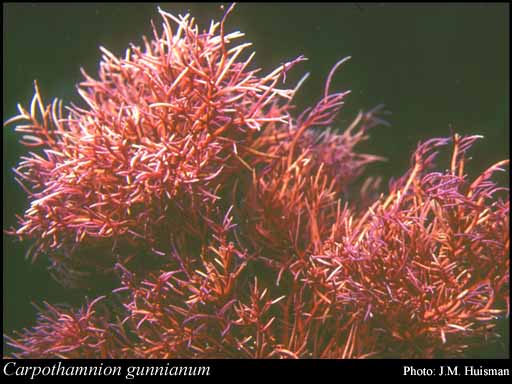- Reference
- Sp.Alg. 668 (1849)
- Conservation Code
- Not threatened
- Naturalised Status
- Native to Western Australia
- Name Status
- Current

Scientific Description
Habit and structure. Thallus erect, dark red-brown, 4–32 cm high, cartilaginous with usually one irregularly branched axis and well developed lateral branches, becoming heavily corticated from close to apices and 1–2 mm in diameter. Holdfast discoid, becoming hapteroid, 0.5–6 mm across, pseudoparenchymatous; epilithic. Structure. Apices when young (or proliferous from older branches) with alternately spirally branched filaments 1–2.5(–4) mm long, forming apical tufts or short laterals when undamaged but easily lost; cells of young axes 20–40 µm in diameter and L/D (0.5–)1–2, lateral branchlets basally branched with long unbranched ends, 20–35 µm in diameter with cells L/D 3–5. Rhizoidal cortication commencing close to branch apices from basal cells of determinate laterals, becoming dense and pseudoparenchymatous, with an outer layer of smaller cells; rhizoids 5–12 µm in diameter, cells L/D 4–10, outermost cells isodiametric, 4–8 µm across. The axial filament gradually enlarges to (150–)250–500 µm in diameter, cells L/D 1–1.5(–2), and remains very conspicuous in section of the branches. Cells uninucleate; rhodoplasts discoid to elongate.
Reproduction. Gametophytes dioecious. Procarps borne on axial cells of the ecorticate apical tufts, with two opposite periaxial cells often 2–3 axial cells apart. One periaxial bears a 4-celled carpogonial branch, and post-fertilization each periaxial cuts off an auxiliary cell and fusion of the carpogonium with both occurs via connecting cells; twin gonimoblasts, each with a foot cell, are initiated, forming rounded, lobed, carposporophytes 100–200 µm across with carposporangia 25–30 µm in diameter. Spermatangia occur in groups on cells of the branchlets, with clusters of initials producing about 4 cells each of which bears outwardly 3–4 spermatangia. Tetrasporangia are borne on cells of the branchlets, singly or with a second younger one, sessile, ovoid, 30–45 µm in diameter, tetrahedrally divided.
Distribution. Houtman Abrolhos, W. Aust., to Phillip I., Vic., and around Tas.
Habitat. C. gunnianum is not common but occurs in scattered localities along southern Australia, from shallow (probably shaded) to deep water.
[After Womersley, Mar. Benthic Fl. Southern Australia IIIC: 267–269 (1998)]
Distribution
- IBRA Regions
- Swan Coastal Plain.
- IBRA Subregions
- Perth.
- IMCRA Regions
- Abrolhos Islands, Central West Coast, Leeuwin-Naturaliste.
- Local Government Areas (LGAs)
- Dandaragan, Fremantle, Greater Geraldton, Mandurah, Rockingham.